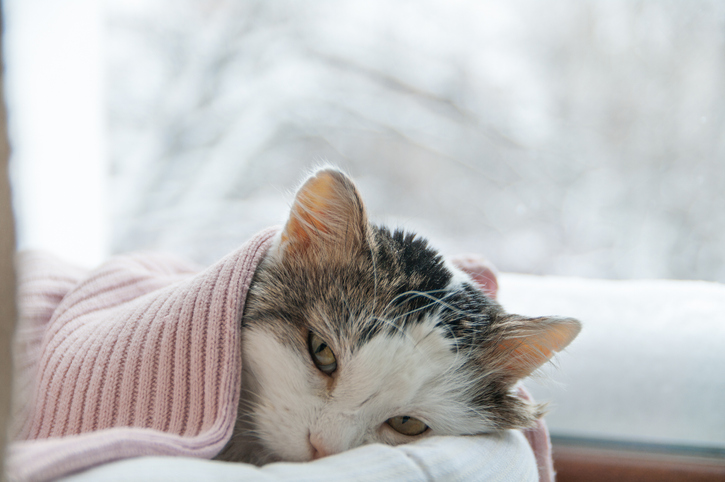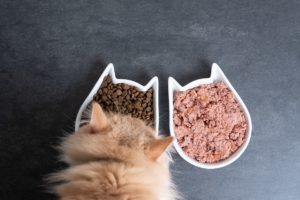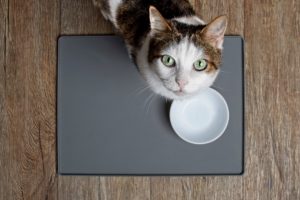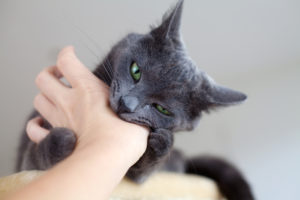Written by: Allison Ward
Some cat owners are surprised to learn that cats can indeed develop diabetes! Just like humans, cats can develop what is referred to as Type 2 Diabetes—and it often comes from a life of leisure and consuming high-calorie foods. How can you tell if your feline friend might be suffering from this condition, and what can you do to minimize his risk? Read on to find out more about diabetes in cats!
What IS Diabetes, Anyway?
To understand why certain symptoms develop when a cat is sick with diabetes, it’s important to understand the basics of diabetes and its effects on a cat’s body. You may recall from high school biology that bodies use a form of sugar, called glucose, as fuel in order to function properly. When your kitty eats her food, your cat’s body breaks down the food into smaller pieces—some of which are glucose.
This glucose enters the bloodstream, where it is either used right away (more on that later!), or stored in the liver in a form known as glycogen. The liver can break down glycogen in the absence of food and put more glucose into the bloodstream to be used as cellular energy as needed.
How Does Insulin Help the Body?
When the blood glucose level rises, certain specialized cells in the pancreas are called into action to release insulin. Insulin is actually a hormone that optimizes a body’s use of glucose energy in many ways. In the bloodstream, insulin escorts glucose into each cell so that the cell can utilize it to perform its own specialized job (whether the cell is a brain cell, kidney cell, intestinal cell….you get the idea!).
In the liver, insulin tells the cells to store glucose in the form of glycogen for the body to use later—and it tells the liver to stop breaking down glycogen in order to prevent excess glucose from being released into the bloodstream.
It’s helpful to think of insulin and the glucose level in the bloodstream as having an inverse relationship: as insulin levels go up, blood sugar (glucose) goes down, and as insulin levels go down, the blood sugar level goes up. The body is constantly optimizing the balance of insulin, glucose, and glycogen all day long, 24/7/365!
How Are Cats Affected by Diabetes?
Cats who develop diabetes are most often suffering from Type 2 diabetes—the same type that we associate with humans acquiring later on in life. In type 2 diabetes, either the cells in the pancreas responsible for releasing insulin aren’t working very well, or cells everywhere else in the body no longer “listen” to the insulin (this is called “insulin resistance”). We know that excess weight and obesity leads to lower sensitivity to insulin, so most of these patients have been significantly overweight for quite a while.
Sometimes the pancreatic cells are not releasing enough insulin AND there is insulin resistance! In these patients, the end result is that the body has a hard time getting glucose into the cells to use as energy. What happens to all of that increased glucose that isn’t being used or stored by the body? Well, after the glucose is at a high enough level in the bloodstream, the body starts peeing out the extra glucose—leading to the most common sign of diabetes in cats: increased urination and increased thirst.
What does the body do for energy if it can’t utilize the glucose flowing throughout the bloodstream? It starts breaking down muscle and fat in a desperate attempt to release other, less efficient, energy sources. Breaking down muscle and fat leads to the second most-common sign of diabetes in cats: weight loss and muscle loss!
Signs of Diabetes in Cats
Increased Thirst and Urination
Healthy cats typically urinate between one and three times per day. If your cat is suddenly urinating more frequently, or urinating and causing huge clumps in the litterbox due to increased urine volume, then please schedule a vet visit as soon as possible!
Cats with diabetes are losing tremendous amounts of glucose through the urine since the body can’t handle the high levels of sugar in the bloodstream. Glucose is a big molecule, and when glucose is passed into the bladder, lots of water has to come with it in order to balance things out in the body. This occurs whether or not your cat is taking in enough water by mouth, so you will notice your cat drinking more water and always seeming thirsty!
Some cats who are excessively thirsty due to diabetes seek out water by drinking from toilets or sticking their nose into their human’s water glasses. However, because so much water is leaving their body in the form of sugary urine, they never seem to satisfy their thirst—no matter how much they drink.
Loss of Muscle
Since cats with diabetes cannot properly use the glucose contained in their food, their body begins to break down muscle and fat to release less-efficient energy sources. While muscle and fat can provide enough energy to survive for a short period of time, this also leads to the buildup of toxic by-products in the bloodstream called ketones—which is why the body typically does not rely on this method of energy production! As a cat parent, you may notice your diabetic cat losing muscle, and the bones in her hips or spine may feel more prominent than usual.
Difficulty Walking
In some diabetic cats, the first complaint noticed by their pet parent is actually difficulty walking. Why is this? Well, nerve cells use glucose just like the cells throughout the rest of the body. If nerve cells cannot get glucose inside of them, then they stop working properly and can no longer coordinate movement with the muscles.
The longest nerves in the body which go to the rear limbs are usually the first to be affected by this condition, called a peripheral neuropathy. Glucose-starved nerves can’t contact leg muscles strongly enough to maintain a cat’s posture, and they begin walking with their ankles on the ground and having difficulty jumping, navigating stairs, and even getting into and out of the litterbox.
General Signs of Illness
Cats are famous for hiding clinical signs and symptoms of illness until they are significantly sick, but some subtle clues that your kitty isn’t feeling her best can also potentially indicate she may be suffering from feline diabetes.
Without glucose to use as energy:
-
- Cats often feel lousy and will be hiding more often
- They may act less social
- Cats may feel nauseated or not want to eat because of the buildup of byproducts from breaking down muscle (diabetic ketoacidosis)
- They may get tired much more easily than usual.
The Bottom Line
As you can see, feline diabetes is an illness that affects the entire body and can cause multiple different symptoms! If you think your cat has feline diabetes mellitus and are wondering how to treat diabetes in cats, chat in with our AskVet veterinarians to see if your cat needs to be evaluated on an emergency basis, or if you can schedule an appointment with your family veterinarian in less-urgent circumstances. We are always here if you have questions about cat diabetes, or any other concerns you may have! Chat in with us 24/7 for all of your pet health needs.
Written by:
Allison Ward, DVM
Dr. Allison Ward grew up in the suburbs of Washington, D.C. and started working in veterinary hospitals when she was 14 years old. After graduating from veterinary school in 2011, she completed a small animal rotating internship in New Jersey, followed by a neurology/neurosurgery internship in Miami. After completing this advanced training, Dr. Ward then moved on to general small animal practice. Dr. Ward’s professional interests include feline medicine, neurology, and pain management. Her passion for educating pet owners carries over into her work with AskVet, and she loves being able to help pets and their parents at all times of the day (and night!). She currently resides in sunny south Florida with her two cats, Larry and George.








